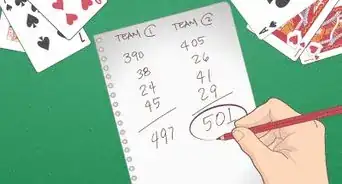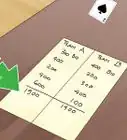This article was co-authored by wikiHow Staff. Our trained team of editors and researchers validate articles for accuracy and comprehensiveness. wikiHow's Content Management Team carefully monitors the work from our editorial staff to ensure that each article is backed by trusted research and meets our high quality standards.
wikiHow marks an article as reader-approved once it receives enough positive feedback. In this case, 85% of readers who voted found the article helpful, earning it our reader-approved status.
This article has been viewed 120,483 times.
Learn more...
Bridge is a 4-player card game played in teams of 2 where bidding is essential for maximizing your score. A bid is when you state out loud to the rest of the players how many “tricks” (or hands) your team will win.[1] There is some strategy involved in bidding, but you can learn how to make successful bids by following some basic rules.
Steps
Making the Opening Bid
-
1Count up your high-card points before you bid. Before you make your first bid in bridge, count up the points you have in your hand. Your high-card points include:[2]
- Ace: 4 points each
- King: 3 points each
- Queen: 2 points each
- Jack: 1 point each
-
2Bid only if you have 13 or more high-card points. Once you have added up your total high-card points, you will know if you should bid or not. You should never open the bid unless you have 13 or more high-card points. If you have less than 13, then you should pass.[3]
- For example, if your hand includes 1 Ace, 1 King, 1 Queen, and 1 Jack as its only high-card points, then your total would be 10 and you should not bid. However, if you have 2 Aces, 1 King, 1 Queen, and 1 Jack, your total would be 14 and you should bid.
Advertisement -
3Announce a no-trump bid if you have between 15 and 17 points. A no-trump bid means that you will take a hand without placing an Ace. If you have a balanced hand with 15 to 17 high-card points, then this is a high likelihood.[4]
- For example, if you have about the same number of cards in each suit, then you have a balanced hand.
- If you have a highly unequal distribution of card suits with 15 to 17 points, then this might not be a good strategy. For example, if you have twice the amount of clubs as hearts, and diamonds, then your hand is unbalanced and you should not risk a no-trump bid.
-
4Open with a 2-suit bid if you have 22 points or more. You can make a 2-suit bid if you have a very high scoring hand. In this case, it is highly likely that you will be able to fulfill the bid with an equivalent number of tricks (hands where you have the highest ranking card).[5]
- For example, if you have 3 Aces, 2 Kings, 2 Queens, and 2 Jacks, your hand would contain 24 high-card points. This means that you should have no problem making a bid of 2 or more suits.
-
5Choose your high-card suit to open. If you open the bid, then you will choose the card that starts the round. Make sure that you choose a card from your high-card suit, which are the cards that you have the most high-card points in.[6]
- For example, if you have 7 high-card points in spade cards, such as an Ace, Queen, and Jack of spades, then open by laying down a spade.
- The card you choose will also help you to signal to your partner which card is your strongest suit, so choose wisely.
Observing the Rotation Rules in Bidding
-
1Allow the dealer to bid first. The dealer is always the first to bid in a round of bridge. Then, play can continue going clockwise from the dealer. If the dealer wishes to pass, then they can say “pass.”[7]
-
2Make a bid higher than or equal to the previous player’s bid. You cannot bid lower than the previous player. Therefore, if the player before you has bid 1 heart, then you would at least have to match that bid with 1 spade, 1 club, or 1 diamond. (You cannot bid with the same suit as the previous player.) You may also bid higher, such as 2 spades, 2 clubs, or 2 diamonds, instead of 1 of these suits.[8]
- Remember that you can say “pass” if you do not want to bid.
-
3Stop taking bids once 3 players in a row have said “pass.” Bidding continues until 3 consecutive players have passed on the chance to bid. The last bid that was made will become the “contract,” and that pair of players will need to complete the number of tricks they bid plus 6. At this point, the game begins and players can start playing tricks, or putting down cards.[9]
- The player who names the final contract suit first is called the “declarer” and their partner is the “dummy.” The person on the left side of the declarer will then make the opening lead. The dummy puts their cards facing up on the table so that the declarer can play with both their cards and their partner’s cards.
Community Q&A
-
QuestionIs there a maximum time one can take to bid or play? What is the accepted standard?
 *~guinea.pigs~*Community AnswerThe least you can bid is 7 tricks. The maximum you can bid is for all 13. The accepted standard is 52 playing cards and each player gets 15.
*~guinea.pigs~*Community AnswerThe least you can bid is 7 tricks. The maximum you can bid is for all 13. The accepted standard is 52 playing cards and each player gets 15. -
QuestionHow many points do you need to open a bid in bridge?
 Drew Hawkins1Community AnswerYou shouldn't open the bid unless you have 13 or more HCP, or high-card points. Any less than that and you should pass. Before you make your decision, count up your high-card points. An ace is worth 4 points, a king is worth 3, a queen is worth 2, and a jack is worth 1. Count them all up to get your total points. If you have a balanced hand with 15 to 17 high-card points, it's a good idea to announce a no-trump bid, which means you will take a hand without placing an Ace. If you have 22 points or more, you can make a 2-suit bid. Whenever you do open your bid, choose a card from your high-card suit.
Drew Hawkins1Community AnswerYou shouldn't open the bid unless you have 13 or more HCP, or high-card points. Any less than that and you should pass. Before you make your decision, count up your high-card points. An ace is worth 4 points, a king is worth 3, a queen is worth 2, and a jack is worth 1. Count them all up to get your total points. If you have a balanced hand with 15 to 17 high-card points, it's a good idea to announce a no-trump bid, which means you will take a hand without placing an Ace. If you have 22 points or more, you can make a 2-suit bid. Whenever you do open your bid, choose a card from your high-card suit. -
QuestionWhat does a 1 club bid mean in bridge?
 Drew Hawkins1Community AnswerA 1 club bid refers to the Strong Club System of bidding. It's a bidding convention and agreement used in a game of contract bridge and is based on an opening bid of 1 club, which is an artificial forcing bid promising a strong hand. The strong 1 club opening is assigned a minimum strength that promises 16 or more HCP, or high-card points. Strong Club Bidding is an advanced ruleset of Bridge, so if you're new to the game, try sticking to the conventional rules. Once you master the basics, you can try giving it a shot!
Drew Hawkins1Community AnswerA 1 club bid refers to the Strong Club System of bidding. It's a bidding convention and agreement used in a game of contract bridge and is based on an opening bid of 1 club, which is an artificial forcing bid promising a strong hand. The strong 1 club opening is assigned a minimum strength that promises 16 or more HCP, or high-card points. Strong Club Bidding is an advanced ruleset of Bridge, so if you're new to the game, try sticking to the conventional rules. Once you master the basics, you can try giving it a shot!
References
- ↑ https://www.youtube.com/watch?v=2IomnCvxWzM&feature=youtu.be&t=1m47s
- ↑ http://pi.math.cornell.edu/~belk/counting.htm
- ↑ http://pi.math.cornell.edu/~belk/opening.htm
- ↑ http://pi.math.cornell.edu/~belk/opening.htm
- ↑ http://pi.math.cornell.edu/~belk/opening.htm
- ↑ http://pi.math.cornell.edu/~belk/opening.htm
- ↑ https://www.acbl.org/learn_page/how-to-play-bridge/
- ↑ https://www.acbl.org/learn_page/how-to-play-bridge/
- ↑ https://www.acbl.org/learn_page/how-to-play-bridge/
About This Article
In Bridge, players bid by stating out loud to the rest of the players how many tricks their team will win. Bidding is done at the beginning of a round, and it consists of a number and a suit. The number is how many tricks a player thinks they'll win, and the suit is whatever trump suit they want for that round. When it's your turn to bid, you need to call out the number of tricks you think your team will win based on the amount of high-card points you have in your hand as well as a trump suit. Bidding starts with the dealer and then goes clockwise around the table. Each player must make a bid that is higher than or equal to the previous player’s bid, or they can say “Pass” if they don’t want to bid. Once 3 players in a row pass on bidding, then the last bid becomes the “contract,” and that pair of players must complete the number that they bid plus 6. To learn how to count up your high-card points before you bid, keep reading!
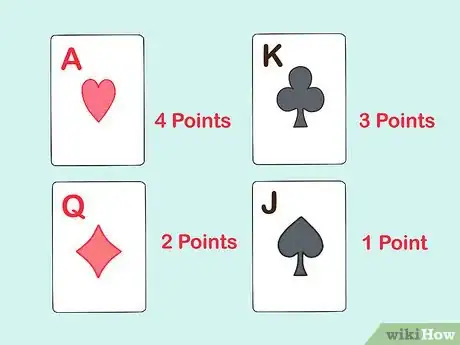
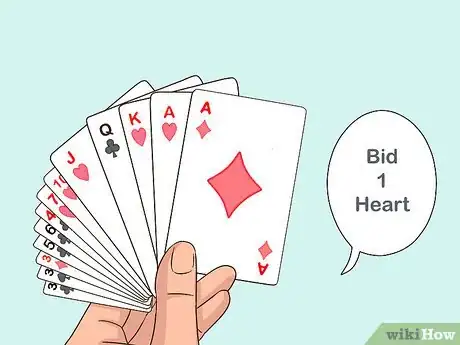
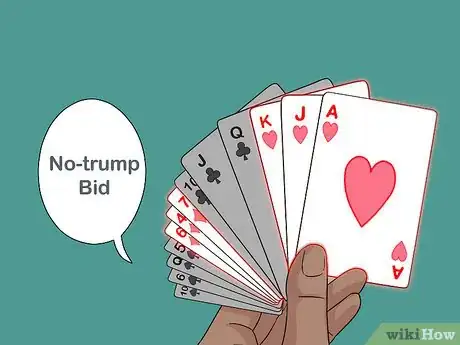

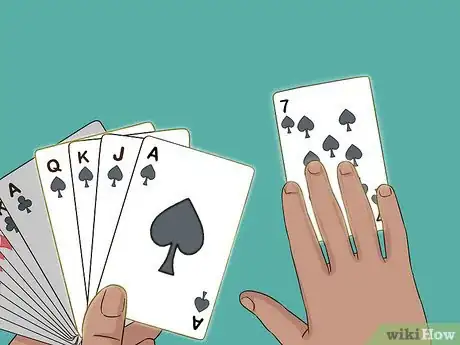


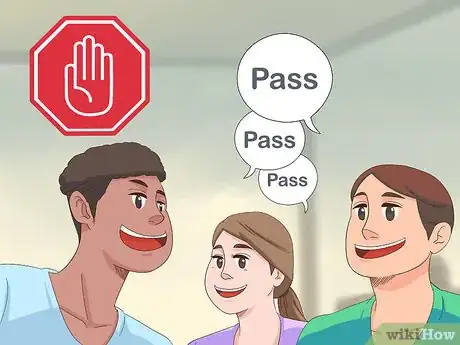
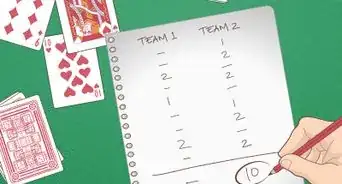
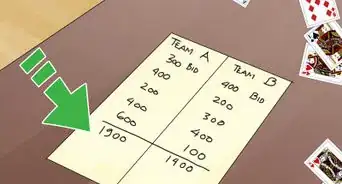

-Step-7-Version-2.webp)


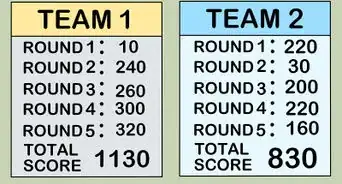
-Step-9-Version-2.webp)

